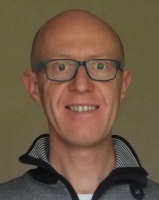Vous êtes ici : Accueil
Le 18 décembre 2018 De 14:00 à 18:00
Soutenance de Thèse : Fabrice David
Publié le 3 décembre 2018 – Mis à jour le 3 décembre 2018

Lieu(x)
Salle 220 (amphithéâtre des thèses) - MSH Clermont-Ferrand
Fabrice David soutiendra sa thèse le 18 décembre 2018 à 14h à la MSH de Clermont-Ferrand (salle 220)
Fabrice David soutiendra sa thèse intitulée "Etude anthropologique de la création chorégraphique d'un spectacle de danse bretonne. Abenn Dimeurh de l'ensemble musique et danse Kevrenn Alré (Bretagne, France)".
Devant le jury composé de :
Et ses co-directeurs de thèse :
Cette thèse s'intéresse au processus de création chorégraphique d'un spectacle de danses traditionnelles en Bretagne. Elle a été menée à partir d’un terrain effectué au sein de la Kevrenn Alré, ensemble de musique et danse bretonnes basé à Auray dans le Morbihan, de novembre 2010 à novembre 2012. Comme la majorité des groupes bretons, cet ensemble crée son spectacle annuel pour le besoin d'un concours organisé par sa confédération. La recherche analyse les activités et les modes collectifs de production mis en œuvre lors de la fabrication du spectacle Abenn dimeurh sur le thème des préparatifs d'une noce en pays d'Auray vers 1900.
La description ethnographique d'un moment de concours et l'analyse des dynamiques internes de la Kevrenn Alré permettent d'abord d'appréhender la relation du groupe à son environnement socio-culturel et d'interroger la façon dont le cadre compétitif façonne le processus de création d'un spectacle. La fabrication d'Abenn Dimeurh est ensuite observée en détaillant les différentes étapes organisées par les chorégraphes : émergence du thème, collectage, présentation du projet aux danseurs, écriture chorégraphique. Cette observation met en lumière la façon dont les responsables de la Kevrenn Alré, pour faire aboutir leur projet artistique, doivent articuler un processus de création nettement ordonnancé et une organisation collective des activités. Au fil du processus sont engagées différentes formes de coopération qui montrent que les acteurs envisagent la notion du collectif et le travail en groupe autour d'une vision commune du sens de l'effort et de la responsabilité partagée. Il se dégage de l’analyse que la définition du travail artistique comme une activité collective est opératoire dans le contexte de la danse bretonne de spectacle en tenant compte des spécificités de l'univers associatif. Dans cet univers, les membres de la Kevrenn Alré s'efforcent de concilier le plaisir du partage et la réussite au concours. De ce constat émerge que le processus de création marque la production de son empreinte en engendrant un spectacle qui exprime leur vision de la culture bretonne.
The ethnographic description of a dance contest and the analysis of Kevrenn Alré's internal dynamics first allow us to understand the group's relationship to its socio-cultural environment and to examine how the competitive framework shapes the creative process of a show. The making of Abenn Dimeurh is then observed by investigating the various steps organized by the choreographers: finding the theme, collecting data, presenting the project to the dancers, making and staging the choreographic score. This observation highlights the way Kevrenn Alré's leaders, in order to carry out their artistic project, must articulate a clearly organized creative process and a collective organization of activities. Throughout the process, various forms of cooperation are initiated, showing that the actors consider the notion of being and working together around a common vision of joint endeavour and shared responsibilities. The analysis shows that the definition of artistic work as a collective activity is operative in the context of Breton folk dance performance, taking into account the specificities of voluntary associations. In this environment, the members of Kevrenn Alré struggle to bring together the pleasure of shared activities and success in the contest. From all this, it emerges that the creative process leaves its imprint on the production by generating a performance that expresses their vision of Breton culture.
Devant le jury composé de :
- Michael HOUSEMAN, Directeur d'études, EPHE Paris, IMAf (Rapporteur)
- Philippe PESTEIL, Professeur des Universités, UBO Brest, Laboratoire LISA (Rapporteur)
- Géraldine RIX-LIEVRE, Professeur des Universités, Université Clermont Auvergne, Laboratoire ACTé
- Daniela STAVELOVA, Directrice de recherche, Institute of Ethnology, Czech Academy of Sciences (CAS), LAPSCO (Rapporteur)
Et ses co-directeurs de thèse :
- Egil BAKKA, Professeur Emérite, Norwegian University of Science and Technology, Deprtment of Music (Co-directeur)
- Georgiana WIERRE-GORE, Professeur des Universités Emérite, Université Clermont Auvergne, Laboratoire ACTé (Co-directrice)
Résumé
Cette thèse s'intéresse au processus de création chorégraphique d'un spectacle de danses traditionnelles en Bretagne. Elle a été menée à partir d’un terrain effectué au sein de la Kevrenn Alré, ensemble de musique et danse bretonnes basé à Auray dans le Morbihan, de novembre 2010 à novembre 2012. Comme la majorité des groupes bretons, cet ensemble crée son spectacle annuel pour le besoin d'un concours organisé par sa confédération. La recherche analyse les activités et les modes collectifs de production mis en œuvre lors de la fabrication du spectacle Abenn dimeurh sur le thème des préparatifs d'une noce en pays d'Auray vers 1900.La description ethnographique d'un moment de concours et l'analyse des dynamiques internes de la Kevrenn Alré permettent d'abord d'appréhender la relation du groupe à son environnement socio-culturel et d'interroger la façon dont le cadre compétitif façonne le processus de création d'un spectacle. La fabrication d'Abenn Dimeurh est ensuite observée en détaillant les différentes étapes organisées par les chorégraphes : émergence du thème, collectage, présentation du projet aux danseurs, écriture chorégraphique. Cette observation met en lumière la façon dont les responsables de la Kevrenn Alré, pour faire aboutir leur projet artistique, doivent articuler un processus de création nettement ordonnancé et une organisation collective des activités. Au fil du processus sont engagées différentes formes de coopération qui montrent que les acteurs envisagent la notion du collectif et le travail en groupe autour d'une vision commune du sens de l'effort et de la responsabilité partagée. Il se dégage de l’analyse que la définition du travail artistique comme une activité collective est opératoire dans le contexte de la danse bretonne de spectacle en tenant compte des spécificités de l'univers associatif. Dans cet univers, les membres de la Kevrenn Alré s'efforcent de concilier le plaisir du partage et la réussite au concours. De ce constat émerge que le processus de création marque la production de son empreinte en engendrant un spectacle qui exprime leur vision de la culture bretonne.
Abstract
This thesis focuses on the process of choreographic creation of a folk dance performance in Brittany. It is based on fieldwork conducted in Kevrenn Alré, a Breton music and dance ensemble based in Auray in Morbihan, from November 2010 to November 2012. Like most Breton groups, Kevrenn Alré create their show to compete in the annual contest organized by the folk dance organization to which they belong. The research analyses the collective activities and modes of production implemented during the creation of the performance Abenn dimeurh on the theme of the preparations for a wedding in the Auray region around 1900.The ethnographic description of a dance contest and the analysis of Kevrenn Alré's internal dynamics first allow us to understand the group's relationship to its socio-cultural environment and to examine how the competitive framework shapes the creative process of a show. The making of Abenn Dimeurh is then observed by investigating the various steps organized by the choreographers: finding the theme, collecting data, presenting the project to the dancers, making and staging the choreographic score. This observation highlights the way Kevrenn Alré's leaders, in order to carry out their artistic project, must articulate a clearly organized creative process and a collective organization of activities. Throughout the process, various forms of cooperation are initiated, showing that the actors consider the notion of being and working together around a common vision of joint endeavour and shared responsibilities. The analysis shows that the definition of artistic work as a collective activity is operative in the context of Breton folk dance performance, taking into account the specificities of voluntary associations. In this environment, the members of Kevrenn Alré struggle to bring together the pleasure of shared activities and success in the contest. From all this, it emerges that the creative process leaves its imprint on the production by generating a performance that expresses their vision of Breton culture.


